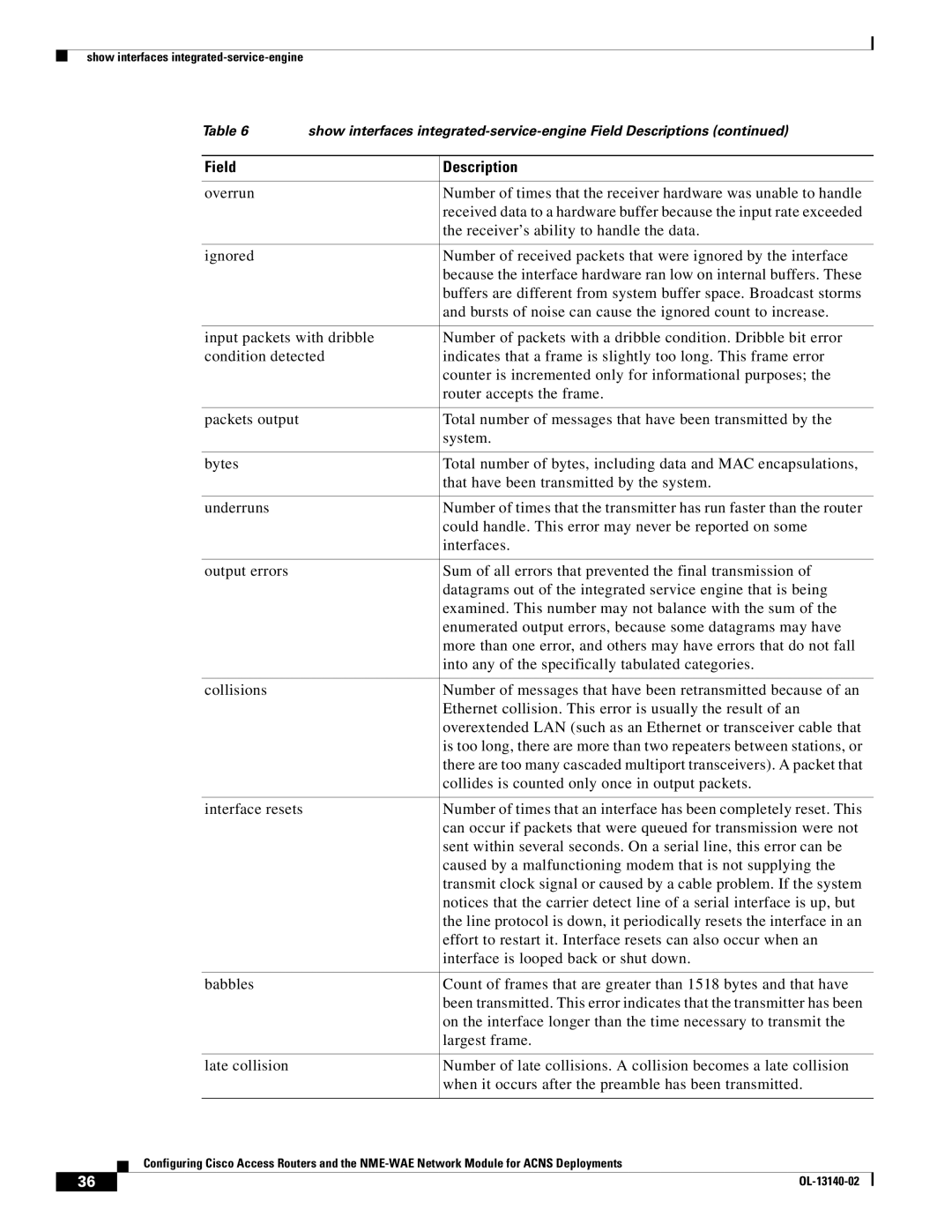show interfaces
|
|
|
| Table 6 | show interfaces | ||
|
|
|
|
|
|
| |
|
|
|
| Field |
| Description | |
|
|
|
|
|
|
| |
|
|
|
| overrun |
| Number of times that the receiver hardware was unable to handle | |
|
|
|
|
|
| received data to a hardware buffer because the input rate exceeded | |
|
|
|
|
|
| the receiver’s ability to handle the data. | |
|
|
|
|
|
|
| |
|
|
|
| ignored |
| Number of received packets that were ignored by the interface | |
|
|
|
|
|
| because the interface hardware ran low on internal buffers. These | |
|
|
|
|
|
| buffers are different from system buffer space. Broadcast storms | |
|
|
|
|
|
| and bursts of noise can cause the ignored count to increase. | |
|
|
|
|
|
| ||
|
|
|
| input packets with dribble | Number of packets with a dribble condition. Dribble bit error | ||
|
|
|
| condition detected | indicates that a frame is slightly too long. This frame error | ||
|
|
|
|
|
| counter is incremented only for informational purposes; the | |
|
|
|
|
|
| router accepts the frame. | |
|
|
|
|
|
|
| |
|
|
|
| packets output |
| Total number of messages that have been transmitted by the | |
|
|
|
|
|
| system. | |
|
|
|
|
|
|
| |
|
|
|
| bytes |
| Total number of bytes, including data and MAC encapsulations, | |
|
|
|
|
|
| that have been transmitted by the system. | |
|
|
|
|
|
|
| |
|
|
|
| underruns |
| Number of times that the transmitter has run faster than the router | |
|
|
|
|
|
| could handle. This error may never be reported on some | |
|
|
|
|
|
| interfaces. | |
|
|
|
|
|
|
| |
|
|
|
| output errors |
| Sum of all errors that prevented the final transmission of | |
|
|
|
|
|
| datagrams out of the integrated service engine that is being | |
|
|
|
|
|
| examined. This number may not balance with the sum of the | |
|
|
|
|
|
| enumerated output errors, because some datagrams may have | |
|
|
|
|
|
| more than one error, and others may have errors that do not fall | |
|
|
|
|
|
| into any of the specifically tabulated categories. | |
|
|
|
|
|
|
| |
|
|
|
| collisions |
| Number of messages that have been retransmitted because of an | |
|
|
|
|
|
| Ethernet collision. This error is usually the result of an | |
|
|
|
|
|
| overextended LAN (such as an Ethernet or transceiver cable that | |
|
|
|
|
|
| is too long, there are more than two repeaters between stations, or | |
|
|
|
|
|
| there are too many cascaded multiport transceivers). A packet that | |
|
|
|
|
|
| collides is counted only once in output packets. | |
|
|
|
|
|
|
| |
|
|
|
| interface resets |
| Number of times that an interface has been completely reset. This | |
|
|
|
|
|
| can occur if packets that were queued for transmission were not | |
|
|
|
|
|
| sent within several seconds. On a serial line, this error can be | |
|
|
|
|
|
| caused by a malfunctioning modem that is not supplying the | |
|
|
|
|
|
| transmit clock signal or caused by a cable problem. If the system | |
|
|
|
|
|
| notices that the carrier detect line of a serial interface is up, but | |
|
|
|
|
|
| the line protocol is down, it periodically resets the interface in an | |
|
|
|
|
|
| effort to restart it. Interface resets can also occur when an | |
|
|
|
|
|
| interface is looped back or shut down. | |
|
|
|
|
|
|
| |
|
|
|
| babbles |
| Count of frames that are greater than 1518 bytes and that have | |
|
|
|
|
|
| been transmitted. This error indicates that the transmitter has been | |
|
|
|
|
|
| on the interface longer than the time necessary to transmit the | |
|
|
|
|
|
| largest frame. | |
|
|
|
|
|
|
| |
|
|
|
| late collision |
| Number of late collisions. A collision becomes a late collision | |
|
|
|
|
|
| when it occurs after the preamble has been transmitted. | |
|
|
|
|
|
| ||
|
|
| Configuring Cisco Access Routers and the | ||||
|
|
| |||||
|
|
|
|
|
|
|
|
| 36 |
|
|
|
|
| |
|
|
|
|
|
| ||
